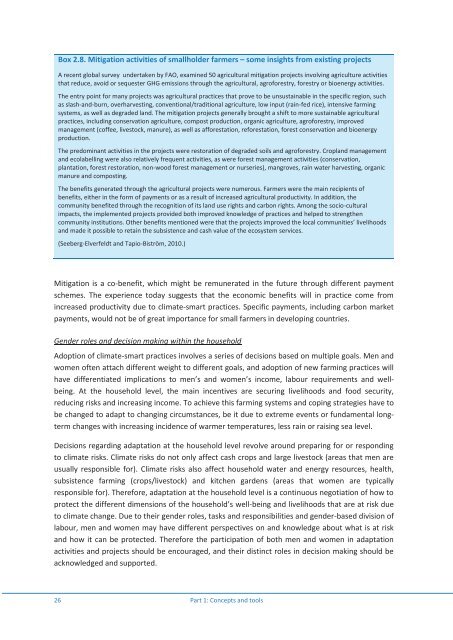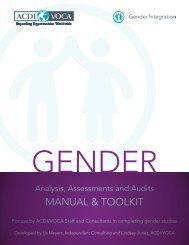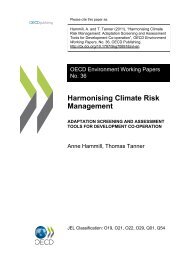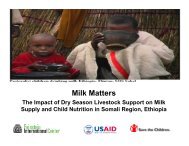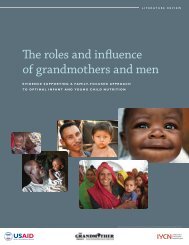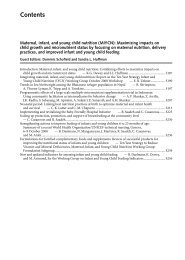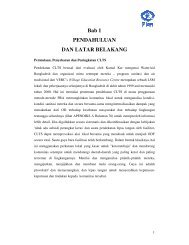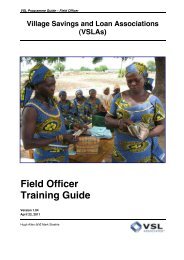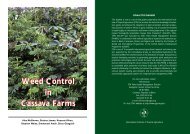Gender and climate change research in - FAO
Gender and climate change research in - FAO
Gender and climate change research in - FAO
Create successful ePaper yourself
Turn your PDF publications into a flip-book with our unique Google optimized e-Paper software.
Box 2.8. Mitigation activities of smallholder farmers – some <strong>in</strong>sights from exist<strong>in</strong>g projects<br />
A recent global survey undertaken by <strong>FAO</strong>, exam<strong>in</strong>ed 50 agricultural mitigation projects <strong>in</strong>volv<strong>in</strong>g agriculture activities<br />
that reduce, avoid or sequester GHG emissions through the agricultural, agroforestry, forestry or bioenergy activities.<br />
The entry po<strong>in</strong>t for many projects was agricultural practices that prove to be unsusta<strong>in</strong>able <strong>in</strong> the specific region, such<br />
as slash-<strong>and</strong>-burn, overharvest<strong>in</strong>g, conventional/traditional agriculture, low <strong>in</strong>put (ra<strong>in</strong>-fed rice), <strong>in</strong>tensive farm<strong>in</strong>g<br />
systems, as well as degraded l<strong>and</strong>. The mitigation projects generally brought a shift to more susta<strong>in</strong>able agricultural<br />
practices, <strong>in</strong>clud<strong>in</strong>g conservation agriculture, compost production, organic agriculture, agroforestry, improved<br />
management (coffee, livestock, manure), as well as afforestation, reforestation, forest conservation <strong>and</strong> bioenergy<br />
production.<br />
The predom<strong>in</strong>ant activities <strong>in</strong> the projects were restoration of degraded soils <strong>and</strong> agroforestry. Cropl<strong>and</strong> management<br />
<strong>and</strong> ecolabell<strong>in</strong>g were also relatively frequent activities, as were forest management activities (conservation,<br />
plantation, forest restoration, non-wood forest management or nurseries), mangroves, ra<strong>in</strong> water harvest<strong>in</strong>g, organic<br />
manure <strong>and</strong> compost<strong>in</strong>g.<br />
The benefits generated through the agricultural projects were numerous. Farmers were the ma<strong>in</strong> recipients of<br />
benefits, either <strong>in</strong> the form of payments or as a result of <strong>in</strong>creased agricultural productivity. In addition, the<br />
community benefited through the recognition of its l<strong>and</strong> use rights <strong>and</strong> carbon rights. Among the socio-cultural<br />
impacts, the implemented projects provided both improved knowledge of practices <strong>and</strong> helped to strengthen<br />
community <strong>in</strong>stitutions. Other benefits mentioned were that the projects improved the local communities’ livelihoods<br />
<strong>and</strong> made it possible to reta<strong>in</strong> the subsistence <strong>and</strong> cash value of the ecosystem services.<br />
(Seeberg-Elverfeldt <strong>and</strong> Tapio-Biström, 2010.)<br />
Mitigation is a co-benefit, which might be remunerated <strong>in</strong> the future through different payment<br />
schemes. The experience today suggests that the economic benefits will <strong>in</strong> practice come from<br />
<strong>in</strong>creased productivity due to <strong>climate</strong>-smart practices. Specific payments, <strong>in</strong>clud<strong>in</strong>g carbon market<br />
payments, would not be of great importance for small farmers <strong>in</strong> develop<strong>in</strong>g countries.<br />
<strong>Gender</strong> roles <strong>and</strong> decision mak<strong>in</strong>g with<strong>in</strong> the household<br />
Adoption of <strong>climate</strong>-smart practices <strong>in</strong>volves a series of decisions based on multiple goals. Men <strong>and</strong><br />
women often attach different weight to different goals, <strong>and</strong> adoption of new farm<strong>in</strong>g practices will<br />
have differentiated implications to men’s <strong>and</strong> women’s <strong>in</strong>come, labour requirements <strong>and</strong> wellbe<strong>in</strong>g.<br />
At the household level, the ma<strong>in</strong> <strong>in</strong>centives are secur<strong>in</strong>g livelihoods <strong>and</strong> food security,<br />
reduc<strong>in</strong>g risks <strong>and</strong> <strong>in</strong>creas<strong>in</strong>g <strong>in</strong>come. To achieve this farm<strong>in</strong>g systems <strong>and</strong> cop<strong>in</strong>g strategies have to<br />
be <strong>change</strong>d to adapt to chang<strong>in</strong>g circumstances, be it due to extreme events or fundamental longterm<br />
<strong>change</strong>s with <strong>in</strong>creas<strong>in</strong>g <strong>in</strong>cidence of warmer temperatures, less ra<strong>in</strong> or rais<strong>in</strong>g sea level.<br />
Decisions regard<strong>in</strong>g adaptation at the household level revolve around prepar<strong>in</strong>g for or respond<strong>in</strong>g<br />
to <strong>climate</strong> risks. Climate risks do not only affect cash crops <strong>and</strong> large livestock (areas that men are<br />
usually responsible for). Climate risks also affect household water <strong>and</strong> energy resources, health,<br />
subsistence farm<strong>in</strong>g (crops/livestock) <strong>and</strong> kitchen gardens (areas that women are typically<br />
responsible for). Therefore, adaptation at the household level is a cont<strong>in</strong>uous negotiation of how to<br />
protect the different dimensions of the household’s well-be<strong>in</strong>g <strong>and</strong> livelihoods that are at risk due<br />
to <strong>climate</strong> <strong>change</strong>. Due to their gender roles, tasks <strong>and</strong> responsibilities <strong>and</strong> gender-based division of<br />
labour, men <strong>and</strong> women may have different perspectives on <strong>and</strong> knowledge about what is at risk<br />
<strong>and</strong> how it can be protected. Therefore the participation of both men <strong>and</strong> women <strong>in</strong> adaptation<br />
activities <strong>and</strong> projects should be encouraged, <strong>and</strong> their dist<strong>in</strong>ct roles <strong>in</strong> decision mak<strong>in</strong>g should be<br />
acknowledged <strong>and</strong> supported.<br />
26 Part 1: Concepts <strong>and</strong> tools


